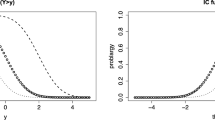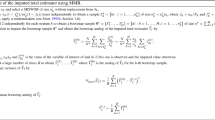Abstract
Additional information contained in incorrect responses calls for a multicategorical rather than a binary analysis of multiple choice data. A nonparametric divided-by-total model for joint maximum likelihood estimation of probability-of-choice functions (for particular responses) and of latent ability is proposed. The model approximates probability functions by rational splines. Some illustrative examples of real test data analysis and the results of a Monte Carlo study are presented.
Similar content being viewed by others
References
Abrahamowicz, M., Ciampi, A., & Ramsay, J. O. (1989). Survival analysis using regression splines. I: Cubic M-splines density algorithm for density estimation (Report 89-32). McGill University, Mathematics and Statistics Department.
Bock, R. D. (1972). Estimating item parameters and latent ability when the responses are scored in two or more nominal categories.Psychometrika, 37, 29–51.
Curry, H. B., & Schoenberg, I. J. (1966). On Polya frequency functions, IV: The fundamental spline functions and their limits.Journal d'Analyse Mathematique, 17, 71–107.
de Boor, C. (1978).A practical guide to splines. New York: Springer-Verlag.
Fletcher, R. (1981).Practical methods of optimization, Volume 2: Constrained Optimization. New York: John Wiley.
Masters, G. N. (1982). A Rasch model for partial credit scoring.Psychometrika, 47, 149–174.
Ramsay, J. O. (1982). Some statistical approaches to multidimensional scaling (with discussion).Journal of the Royal Statistical Society, Series A, 145, 285–312.
Ramsay, J. O. (1988). Monotone regression splines in action (with discussion).Statistical Science, 3, 425–461.
Ramsay, J. O., & Abrahamowicz, M. (1989). Binomial regression with monotone splines: A psychometric application.Journal of the American Statistical Association, 84, 906–915.
Samejima, F. (1969). Estimation of latent ability using a response pattern of graded scores.Psychometrika Monograph No. 17, 34 (4, Pt. 2).
Samejima, F. (1979).A new family of models for the multiple choice item (Research Report No. 79–4). University of Tennessee, Department of Psychology.
Silverman, B. W. (1985). Some aspects of the spline smoothing approach to nonparametric regression curve fitting (with discussion).Journal of the Royal Statistical Society, Series A, 47, 1–50.
Thissen, D., & Steinberg, L. (1984). A response model for multiple choice items.Psychometrika, 49, 501–519.
Thissen, D., & Steinberg, L. (1986). A taxonomy of item response models.Psychometrika, 51, 567–577.
Thissen, D., Steinberg, L., & Fitzpatrick, A. R. (1989). Multiple-choice models: The distractors are also part of the item.Journal of Educational Measurement, 26, 161–176.
Wegman, E. J., & Wright, J. W. (1983). Splines in statistics.Journal of the American Statistical Association, 78, 351–366.
Winsberg, S., & Ramsay, J. O. (1983). Monotonic spline transformations for dimension reduction.Psychometrika, 48, 403–423.
Winsberg, S., Thissen, D., & Wainer, H. (1984). Fitting item characteristic curves with spline functions (Tech. Rep. No. 84-52). Princeton, NJ: Educational Testing Service.
Author information
Authors and Affiliations
Additional information
The research in this paper was supported by the National Sciences and Engineering Research Council of Canada Grants OGP0105521 and APA 320 awarded to the first and the second author, respectively. The authors are indebted to R. Melzack and A. Baker for making available the data analyzed in this paper. We would also like to thank J. McKenna and B. Cont for their assistance in editing this paper.
Rights and permissions
About this article
Cite this article
Abrahamowicz, M., Ramsay, J.O. Multicategorical spline model for item response theory. Psychometrika 57, 5–27 (1992). https://doi.org/10.1007/BF02294656
Received:
Revised:
Issue Date:
DOI: https://doi.org/10.1007/BF02294656




